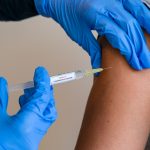Increasing number of “BREAKTHROUGH” cases of COVID-19 reported among people receiving the jab
 (NaturalHealth365) Well over a year into the pandemic, mainstream media continues to espouse the benefits of COVID shots while downplaying growing reports of adverse reactions. This week, we’ve also seen the U.S. Centers for Disease Control and Prevention (CDC) quickly backpedal on an unsubstantiated statement from CDC director Dr. Rochelle Walensky, who irresponsibly claimed that people who have had the COVID shot “don’t carry the virus.”
(NaturalHealth365) Well over a year into the pandemic, mainstream media continues to espouse the benefits of COVID shots while downplaying growing reports of adverse reactions. This week, we’ve also seen the U.S. Centers for Disease Control and Prevention (CDC) quickly backpedal on an unsubstantiated statement from CDC director Dr. Rochelle Walensky, who irresponsibly claimed that people who have had the COVID shot “don’t carry the virus.”
On the contrary, there is no conclusive evidence showing that “fully vaccinated” people can’t transmit SARS-CoV-2. Still, a breaking number of so-called “breakthrough” cases of COVID-19 in Washington, Florida, and elsewhere are occurring in people who have already received their jabs.
Breaking: At least 100 “fully vaccinated” people in Washington State test positive for COVID-19
In a public statement released on March 30, 2021, the Washington State Department of Health (DOH) acknowledged that 102 “breakthrough” cases of COVID-19 had occurred so far in the Pacific Northwest state — since February 2021 alone. It’s certainly a small amount compared to the 1 million Washingtonians who have already received their two doses. However, of these 100+ people — who all tested positive for COVID-19 at least two weeks after their final dose of the COVID injection — eight required hospitalization, and two died.
Breakthrough cases are “expected with any shot,” according to Washington’s DOH. This could be due to several factors, including viral mutations, injection quality, poor sleep in the weeks leading up to receiving the injection, and advancing age. Indeed, it’s already well-established that other shots, including the flu shot, are less effective in people older than 65, as noted by a 2014 review from Nature Immunology. It’s entirely plausible that the same phenomenon is happening here and in states like Florida, South Carolina, Texas, New York, California, and Minnesota, where dozens of breakthrough COVID-19 are being documented.
Of course, neither Pfizer nor Moderna are willing to claim that their injections are 100% effective, to begin with (although Pfizer boldly makes this claim regarding its early and highly controversial mRNA research in children). This brings us to another question worth revisiting:
What does an “effective” COVID shot actually mean?
Latest data from Pfizer suggests shot is “effective” for six months — but what does effective really mean?
In a recent statement from Pfizer, Pharma executives claim that current data suggests their shots are 91.3% effective against symptomatic COVID-19 and 95.3% effective against severe COVID-19. In case you missed the nuance there, here’s another way to look at these claims:
Pfizer does not claim that their injections prevent transmission, reduce the spread of the disease, or even prevent someone from getting infected. They are only claiming that getting a shot will reduce the risk that a person will get symptoms if they end up contracting the virus — a virus that causes only mild or even no symptoms in 8 out of 10 people who come across it.
If you’re confused, we don’t blame you. Many other organizations and news outlets will claim that the COVID-19 injection will help reduce the transmission of the virus, even though government officials and Pharma execs readily acknowledge that there’s not enough evidence yet to fully support this contention.
The U.S. Centers for Disease Control and Prevention (CDC) admits to this lack of data on their website using the euphemistic phrase “we are still learning” (aka: they don’t know). Interestingly, the CDC claims on the same webpage that the jab is effective at “keeping you from getting COVID-19” and later revises this as “keeping you from getting sick.”
To critics and medic freedom proponents, this isn’t just a matter of semantics. Yes, COVID-19 is the disease caused by SARS-CoV-2, but the two are often used interchangeably, contributing to the confusion. And not getting COVID-19 vs. not getting symptoms of COVID-19 are two completely different outcomes, at least in terms of “slowing the spread.”
Individuals are encouraged to do their research when government and public officials continue to make updated recommendations and claims to understand why these recommendations are being made and upon what data such recommendations are based.
Sources for this article include:
Childrenshealthdefense.org
LiveScience.com
NIH.gov
UCSF.edu
Pfizer.com
Fortune.com
NYtimes.com
DOH.wa.gov
CDC.gov
NIH.gov
NBCnews.com



